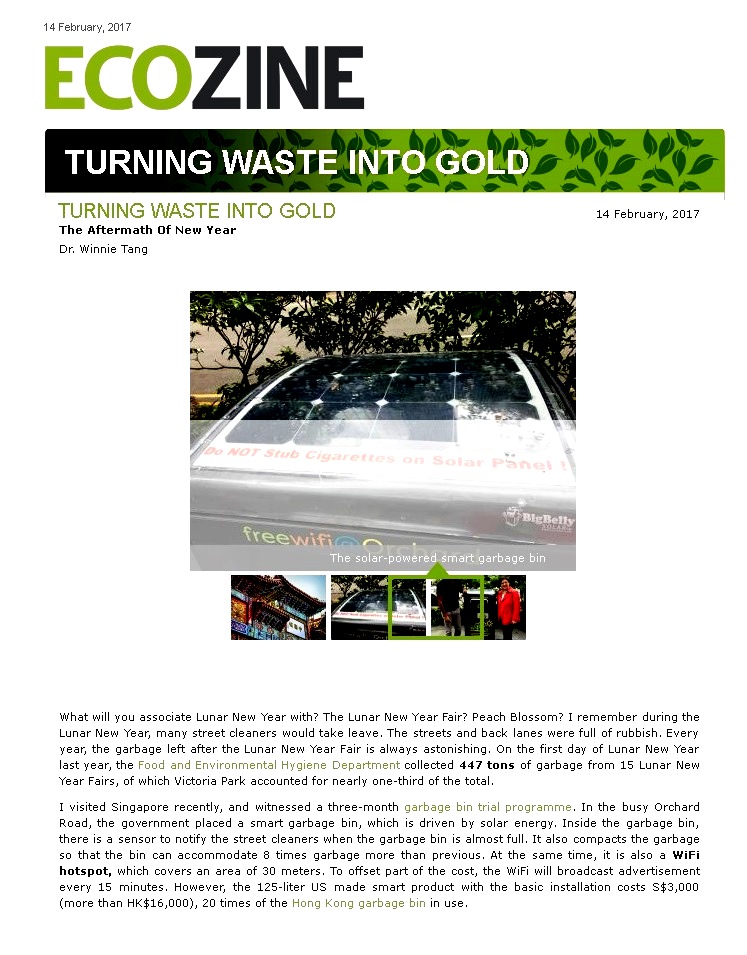

TURNING WASTE INTO GOLD
What will you associate Lunar New Year with? The Lunar New Year Fair? Peach Blossom? I remember during the Lunar New Year, many street cleaners would take leave. The streets and back lanes were full of rubbish. Every year, the garbage left after the Lunar New Year Fair is always astonishing. On the first day of Lunar New Year last year, the Food and Environmental Hygiene Department collected 447 tons of garbage from 15 Lunar New Year Fairs, of which Victoria Park accounted for nearly one-third of the total.
I visited Singapore recently, and witnessed a three-month garbage bin trial programme. In the busy Orchard Road, the government placed a smart garbage bin, which is driven by solar energy. Inside the garbage bin, there is a sensor to notify the street cleaners when the garbage bin is almost full. It also compacts the garbage so that the bin can accommodate 8 times garbage more than previous. At the same time, it is also a WiFi hotspot, which covers an area of 30 meters. To offset part of the cost, the WiFi will broadcast advertisement every 15 minutes. However, the 125-liter US made smart product with the basic installation costs S$3,000 (more than HK$16,000), 20 times of the Hong Kong garbage bin in use.
In fact, many countries are aware of the urgency of garbage problem. Developing countries such as those in South America are also moving towards high-tech solution. Bogotá, Buenos Aires, Mexico City and San Diego are adopting digital tracking garbage trucks; Colombia is testing the solar smart garbage bin made by South Korea. The current issue remains how to reduce the cost of smart garbage bin.
Garbage generates vast business opportunities, however, garbage or waste management poses great business opportunities. Bank of America Merrill Lynch estimated the market potential with waste management would be up to US$2 trillion by 2020 as waste output was forecasted to double between 2005 and 2025.
The investment bank pointed out that 70% of global waste will eventually be dumped to landfills and only 20% to 30% will be recycled. For example, China's urban waste drastically increased from 30 million tons in 1980 to 210 million tons in 2010, a big jump of 7 times in 30 years. There is huge demand for industrial waste treatment, waste to energy, waste water and sewage treatment, recycling, and their related engineering and consultancy services.
The United Nations Environment Programme also pointed out that the waste is a gold mine, for example, a ton of old mobile phones contain gold that is 65 times of the same weight of ore. Europe is now developing waste disposal treatment in full swing, we shall not underestimate the market demand in Asia and South America.
Turning incinerator into ski field
In Denmark, only 4% of the waste will be dumped to landfills. More than half of the waste is incinerated, while the remaining will be recycled. The Amager Bakke incinerator in Copenhagen, to be completed this year, is also an artificial ski field. It has a 440 meters piste with four types of slope for skiing. At the same time, it will produce heat for 160,000 households and electricity for 62,500 residences, and generates 1/4 more electricity than the old incinerators.
Hong Kong is also troubled by the waste disposal problem and the landfills are about to overflow. I sincerely hope that the innovatorsand technology workers, especially young people, will spend more time and effort to tackle such global issue in pursuit of a brighterfuture for the society and for themselves!
Dr. Winnie Tang
Honorary Professor, Department of Computer Science, The University of Hong Kong